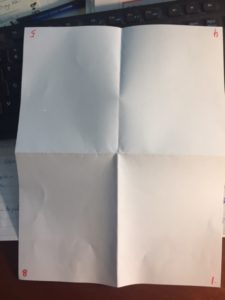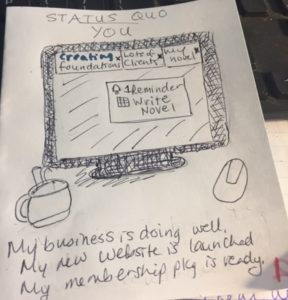And they lived happily ever after…
Usually this sentiment is associated with romance, marriage to a prince and getting to live in a castle for the rest of your life. These days, we have more varied dreams and desires. What might your fairy tale ending be?
And her book became a bestseller, and she was an instant millionaire
And she performed on The Late Show and found her adoring fans
And his song was covered by Lady Gaga, and hit Number 1 on the Billboard charts
And his screenplay was optioned and had Julia Roberts attached
And her pilot was greenlighted for production
We writers harbor and hope for so many lovely dreams. But we know if we read the fictional story that ended with any of those fairy tale endings, the protagonists would have been to hell and back to be delivered to such an exalted state. There’s no getting from here to there without suspense, surprise and plenty of challenges and revelations, right. In fact, the 8 phases of the story might have been:
- Let’s say (YOU) the protagonist is sitting around in your office
- Wishing for any one of those fairy tale endings (NEED).
- You have to get going. (GO)
- You SEARCH for a solution, and when that doesn’t work, you keep searching.
- You FIND what you want – but things go a little sideways.
- TAKE what you find and need – but there’s going to be a price to pay. Here is where you push the protagonist really to the brink – near death, or loss of all life that you cherish.
- RETURN to your ordinary world, but you’re changed. Your trajectory is changed. Your NEED is different. You realize something very important about your original NEED.
- CHANGE – your changed self is tested. Are you really finally the new person you purport to be? There is one more showdown, and you triumph, to win the fairy tale ending.
These story phases come from Dan Harmon’s Eight Point Story Circle. How can we use a plotting tool to help us visualize the path we must take to live our own stories? How can we make our lives unfold, as we hope, heroically?
Storyboarding tool
I like to use a tool called storyboarding, which is borrowed from animation. Create a chart that is two rows of four squares (8 boxes).
Label each box with the capitalized words above.
1- YOU //In box one, you put yourself, and the status quo
2- NEED // Something is wrong, what is it? What is your need/drive/desire?
3- GO // Where will you go? What will you do? (This could be writing, or building a platform, or both)
4- SEARCH // What things will you try? What do you need to learn? Who do you need to meet?
5- FIND // What will you find? How will it finally appear/happen?
6- TAKE // You take what you need. This is important to visualize. You deserve the thing you need. Take it.
7- RETURN // You’re back in your office. Is anything changed? How are you different? (It’s in a castle? on the lot? in a Hollywood mansion?)
8- CHANGE // You have changed – but how? What did you need to learn about yourself, your craft, the industry to get to this point? What if someone now tried to take all that away? Would you be prepared to fight for it?
And she lived happily ever after…
NOW, one more trick! To help your mind fill in these boxes without resistance, do them out of order.
Do box #1 – YOU. You know your status quo – easy peasy. Draw or write about it in box #
Now skip to #8 CHANGE. Imagine who you would be if the storybook ending were delivered to your doorstep? What battles? What quests did you undertake and how did that change who you are at the end of the story?
Do box #2 NEED. You probably know your need. You need to be published, produced, purchase, optioned, performed.
Skip again to Box 7. RETURN. You just got the good news. Your NEED is met. You’re back in your regular life, but this has happened. Huzzah. What else? Are you tired? Do you appreciate the little things?
Backtrack to Box 3 – GO. Where do you need to go? Who do you need to talk with? Do? Remember GO is all actions – it could include the actual writing. You’re writing this story based on where you actually are as of right now.
Now jump to Box 6 – TAKE. You find it. You take it. What is it like in your life? What happens in the morning on the day you are going to have the meeting/sign the papers/get the award? How does that day go? Who do you meet? Where do you have lunch? What are you wearing? What are you very glad you know or have with you?
Back to Box 4 – SEARCH. this could/should be 4 boxes of its own. What things are you trying? Where do you look, call, email, DM, PM, or meet with? What questions do you ask? What clues do you find? What do you have to learn? earn? find?
Now, it’s easy. Only box 5 is left. And this is the FIND box. Imagine the day when you find your way in, your perfect pitch, the story that soars – whatever it is that ends your SEARCH and delivers you to the right door, the right guy, the best option, the person who believes in you and can do something about it.
Another format
You could do this with any 8 point plot arc:
1 – stasis, 2- trigger, 3- quest, 4- surprise, 5- critical choice, 6- climax, 7-reversal, 8- resolution.
One Step Further
And then I take it one step further and turn the storyboard into a book, so I can read it. I don’t know why, but when I read it in a book, I believe it. I visualize it differently, and when we’re talking about seeing your future – a story book is called for.
All you need to do is take a regular piece of 8-1/2 x 11″ paper (or any size for that matter) and fold it in half and then in half again. You’re making a booklet.
Then, with the spine on the left, number the pages 1-8. Notably, page 2 is on the back of page one, so you have to bend the paper back to number it correctly in the lower right hand corner. You could do this in pencil, if you don’t want page numbers in your final book.
When you open your paper back up, it will look like this.


 So you follow the instructions above. Fill the pages in the same order 1, 8, 2, 7, 3, 6, 4, 5. This order allows your brain to imagine instead of resist. In the storybook, you’ll notice the page numbers are sometimes upside down. That’s as it should be. Your content on the page must be in the same orientation as the number you wrote when it was in booklet form. (Page number appears right side up in lower right hand corner.)
So you follow the instructions above. Fill the pages in the same order 1, 8, 2, 7, 3, 6, 4, 5. This order allows your brain to imagine instead of resist. In the storybook, you’ll notice the page numbers are sometimes upside down. That’s as it should be. Your content on the page must be in the same orientation as the number you wrote when it was in booklet form. (Page number appears right side up in lower right hand corner.)
Fill in page 1, then page 8. Turn the page over, and do pages 2 and 7. Flip the page again and do the 3 and 6 pages. Turn the page over one more time, and you’ll find pages 4 and 5. Draw your drawings, use your captions, create your storybook with its fairy tale ending. Now refold your booklet. Staple its spine, and cut the top or bottom fold, as necessary. Flip through the pages of your book and read your story. Let it sink in.